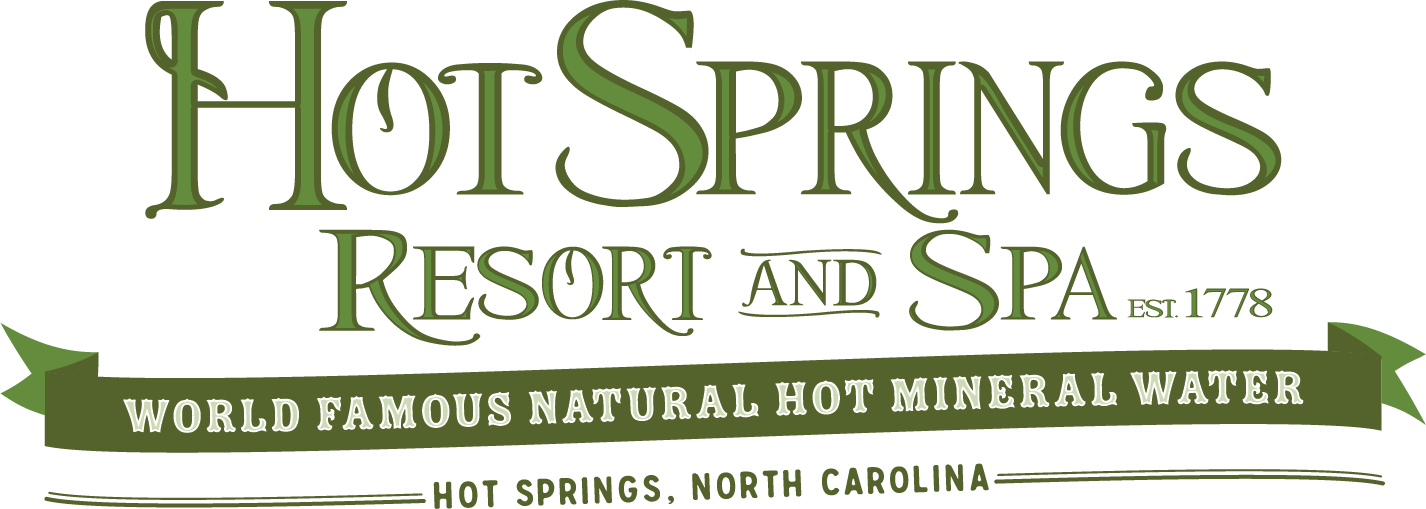1788

The completion of the Bumcombe Turnpike put the small town of Warm Springs, NC on the map as drivers moved livestock from Greeneville, TN to Greenville, SC.
1830

Wade Hampton, war hero and governor of South Carolina, built the Hampton Cottage along the Buncombe Turnpike as a respite for weary travels and serves as the first incarnation of a hotel in Hot Springs.
1832

The Patton brothers bought the existing Hampton Cottage and began improvements for what was to become the Patton Hotel.
1839

Colonel James Rumbough brought the Patton Hotel and property.
1884

The Patton Hotel burned and work began on the most grand hotel to sit on the property, The Mountain Park Hotel. The Mountain Park Hotel was home to North Carolina’s first golf course.
Spending great sums of money, the four story Mountain Park Hotel was built in 1884 along with the first golf course in North Carolina and a bathhouse was built over the springs. The hotel was done in an elegant Swiss style of architecture with the latest styled Mansard roof. There were 200 bedrooms all lighted by electricity and heated by steam. The modern bathhouse held 16 marble pools each one measuring 9 feet long, 6 feet wide and up to 6 feet deep. After the bath, the patient would walk to another room and receive a massage or other treatment depending on his condition. The typical treatment plan consisted of 21 days of baths and massage therapy. ??The first golf course in the state was a nine hole course adjacent to the hotel. It was called the Wana Luna. The tees and greens were square. The “gutta percha” balls were swept away instead of driven, as today.
The Southern Improvement Company went bankrupt in the process of rebuilding the resort and offered the property back to Col. Rumbough. He bought it and once again became owner and manager for the famous hotel which catered to the fashionable crowd. Many tourists came to the hotel for the curative values of the waters, but other guests were the South’s elite who came summer after summer to enjoy the social life for which Hot Springs had become famous. There were amusements of every variety: bowling alleys, billiard rooms, tennis courts, swimming pools, riding stables, a golf course, amateur theatricals, and an orchestra playing for dances every evening in the large ballroom. There was a fifth of a mile of glass enclosed porches which kept out the chickens and other animals which had roamed on the porches of the old hotel.
1913

Due to a decline in tourism Colonel Rumbough leased the property to the United States government. The property was used as an internment camp for German Merchant Sailors.
Things went well with the Mountain Park until the outbreak of World War I. Carrie Rumbaugh died in 1913. Travel to the hotel slowed considerably. Col. Rumbough negotiated a contract with the War Department to house Germans who were in N.Y. Harbor on luxury liners when war was declared. Consequently, 2500 passengers, officers and crew members came by train to Hot Springs. Officers were put into the hotel. Women found rooms in town. They were excellent dressmakers and sewed for the townspeople. The brass band from the VADDERLAND ship practiced each day and gave concerts for the townspeople every Sunday afternoon. The German men built a small village on the lawn of the hotel using scrap lumber, driftwood and flattened tin cans. The chapel was built of flattened Prince Albert Tobacco tins and was large enough to hold a few people for worship. Lacking paints, they ingeniously compounded mixtures of berry juices and colored clays to brighten the walls of their village (for more information and a pictorial history, please read: The German Invasion Of Western North Carolina…available in our gift shop)
1916

The Great Flood damaged the hotel considerably. The German Village, tents and barracks were all washed away. The guests all escaped to higher ground. No lives were lost. The whole town watched as the great flood washed by carrying cotton bales, animals, turkeys, chickens, furniture, trees, caskets from the casket plant at Woodfin, and even a whole house with the rocking chair still rocking back and forth on the porch. After the flood, repairs were made to the hotel and the swimming pool was excavated from the fill dirt brought by the flood.
1920

The Mountain Park Hotel burned.
1924

Bessie Safford, daughter of Col. Rumbough, acquired the property and built The Hot Springs Inn. She had intended it to be a sanitarium but the plan never materialized. She conveyed the property to the Catholic Church for a retreat and rest home. It was used only briefly for this purpose, largely due to the remoteness of the area and to the fact that there were few Catholics in Madison County.
1977

The Hot Springs Inn that had fallen into decline and burned.
1990

Eugene Hicks bought the current day Hot Springs Resort & Spa property and began work on the spa that we have today.

